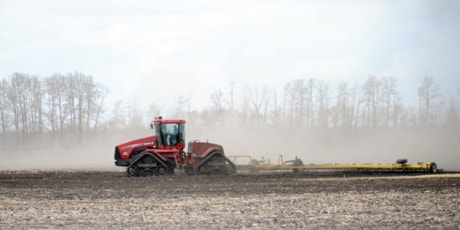After being kept out of their fields by lingering cool weather, Central Alberta farmers are making up for lost time.
Air seeders were in evidence late last week, and continue to crisscross the rural landscape.
“About Thursday, Friday farmers started getting going and then all weekend there was a lot of seeding going on,” said Neil Whatley, a crop specialist with Alberta Agriculture and Rural Development’s Ag-Info Centre in Stettler.
“People are going, they’re going hard. It’s getting to the time where the crops have got to get into the ground in order to avoid excessive heat at a certain (vulnerable) stage in July.”
Seeding is probably a week to 10 days behind usual timelines, said Whatley.
This is the consequence of cooler-than-normal soil temperatures this spring.
Even producers in east-Central Alberta, who normally get a jump on their counterparts to the west, had to wait.
“Everybody has held back this year, even east of No. 2 Highway.”
Despite the delay, producers shouldn’t have to revert to faster-maturing crops to make up for lost time this spring.
“With the big implements we have these days, they can get around their crop pretty quick,” said Whatley. “They’ll be going night and day now to get it into the ground.”
The cooler temperatures forecast for later this week shouldn’t impact crops already seeded, he added.
Soil temperatures are now warm enough for germinating seeds even if surface temperatures drop.
Whatley expects to see more acres seeded to field peas this year.
That’s because many farmers will opt for legumes, which don’t require as much nitrogen, to minimize the sting of high fertilizer prices. Additionally, he said, the growing threat of clubroot is prompting many farmers to reduce the frequency of canola in their rotations.
“To replace that one year of rotation, they’re inserting a field pea into their rotation.”
Red Deer County remains at moderate risk for clubroot, but Lacombe, Ponoka and Wetaskiwin counties, and other rural municipalities to the north, have been confirmed as clubroot zones.
In addition to encouraging farmers to lengthen their crop rotations, agricultural officials are urging them to ensure equipment is clean when moving between fields to guard against the fungal spore.
Other concerns going into the 2009 crop year include wheat midge, which made a strong movement into the province last year, said Whatley. The extent of that threat should become clearer by July, he added.
As for moisture reserves, Whatley said most of the province is in good shape. The exception is eastern Alberta, with Paintearth County the transition point.
“Once you get to Consort, it’s dry. South to Hanna is dry, too.”
hrichards@www.reddeeradvocate.com
